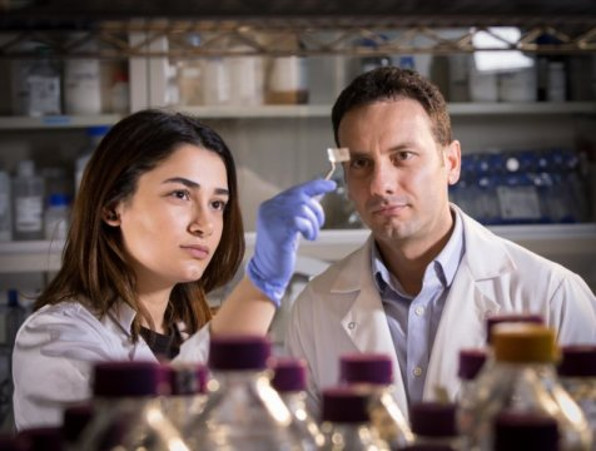No more guess work about that stuff in the back of the fridge! Is it still good? Or should you throw it out? Researchers at McMaster University in Canada have come up with a material that can detect food poisoning bacteria. And you’ll be able to read results directly from the unopened package…
 Members of the McMaster University development team examine a sample of the
Members of the McMaster University development team examine a sample of the
Sentinel freshness patch… Coming soon, we hope, to a supermarket near you!
It’s an age-old problem. Or, if you look at it in its most precarious light, a game of dietary Russian Roulette.
Is that meat you bought several days ago still safe to eat? Or is it riddled with food poisoning bacteria? Until now, there was no way t know short of a lab analysis. But how many of us keep a clinical grade microscope in our pantries?
Food borne pathogens cause widespread serious illness and death every year. According to the World Health Organization, these pathogens result in approximately 600 million illnesses and 420,000 deaths annually. About 30 per cent of those cases involve children five years old and younger.
A simple patch…
McMaster University scientists have developed a transparent patch printed with harmless molecules that react to the presence of contaminants such as E. coli and Salmonella. The patch can be incorporated directly into packaging for many kinds of foods which are prone to spoilage.
Chemical and mechanical engineers at McMaster worked closely with biochemists to develop he new coating. It’s inexpensive, simple, cheap and reliable, and would be easy for manufacturers and packagers to in corporate into their production processes.
What it means…
The inventors predict that, if widely adopted, the ‘Sentinel Wrap’ patch will supersede the current universal standard of ‘Best Before’ dating. The ‘Best Before’ method of assuring folks don’t eat bad food is only a general indication of he wholesomeness of foods prone to spoilage. manufacturers place very conservative ‘Best Before’ dates on their products to help ensure that nothing bad gets to your table. That means, a lot of food that’s still okay to eat get thrown out – ‘just in case’. Now, and especially in the future, we can’t afford to throw out good food!
Getting the invention to market would need a commercial partner and regulatory approvals, the researchers say. They point out that the same technology could also be used in other applications, such as bandages to indicate if wounds are infected, or for wrapping surgical instruments to assure they are sterile.
The McMaster team has not predicted how soon the Sentinel system will be in common use. But some work remains to perfect the mass production process for the new patch.
~ Maggie J.

